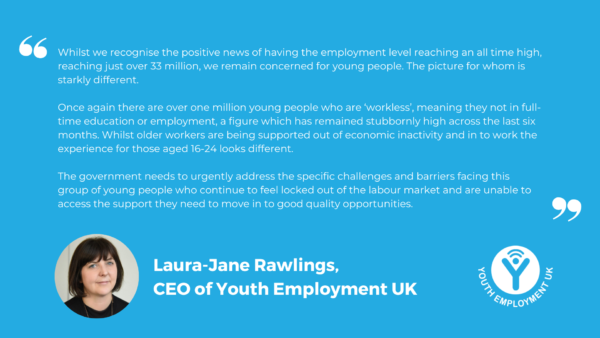The ONS have released the latest Labour Market Overview covering the months of February 2023 – April 2023.
What does this mean for Youth Employment?
The latest labour market overview from the Office for National Statistics shows that the youth employment rate has decreased by 0.34 percentage points to 10.93%, but it is still nearly three times the all-age rate, with 464,700 16-24-year-olds unemployed (including students).
Headlines for young people aged 16-24
In work:
| Employment rate | Employment Level |
| 55.5% (↓0.2%) | 3,798,000 (↓9,782) |
Unemployment:
| Unemployment rate | Unemployment Level | 10.93% (↓0.34%) | 464,700 (↑18,000) |
Economically inactive:
| Economically inactive rate | Economically inactive level | 37.4% (↑0.4) | 2,592,000 (↑30,300) |
Education:
| In full-time education | Not in full-time education |
| 3,025,000 (↑21,000) | 3,816,000 (↓19,000) |
Worklessness:
| Not in full-time education or employment | |
| 1,051,000 (↑35,000) | |
| Economically inactive
(not in full-time education) |
Unemployed (not in full-time education) |
| 682,000 (↑18,000) | 321,000 (↑10,000) |
Headlines for all ages
In work:
| Employment rate | Employment Level |
| 76.0% (↑0.1%) 16-64 | 33,089,000(↑94,000) |
Unemployment:
| Unemployment rate | Unemployment Level |
| 3.8% (↓0.1%) | 1,305,000 (↑25,000) |
Economically inactive:
| Economically inactive rate | Economically inactive level |
| 21.0% (↓0.2)16-64 | 8,718,000 (↓13,000) 16-64 |
Commentary
This month’s employment figures show that the number of young people not in full time education or employment has grown to over 1 million again. We continue to be concerned by the proportion of young people who are not in full time education or employment and are economically inactive, accounting for around 7 in 10 young people who are neither earning or learning. We know that there are long term risks for these young people and their futures, as well as the wider UK economy, if we do not address the barriers they are facing to employment.
CEO, Laura-Jane Rawlings:
“Whilst we recognise the positive news of having the employment level reaching an all time high, reaching just over 33 million, we remain concerned for young people. The picture for whom is starkly different.
Once again there are over one million young people who are ‘workless’, meaning they not in full-time education or employment, a figure which has remained stubbornly high across the last six months. Whilst older workers are being supported out of economic inactivity and in to work the experience for those aged 16-24 looks different.
The government needs to urgently address the specific challenges and barriers facing this group of young people who continue to feel locked out of the labour market and are unable to access the support they need to move in to good quality opportunities.”







